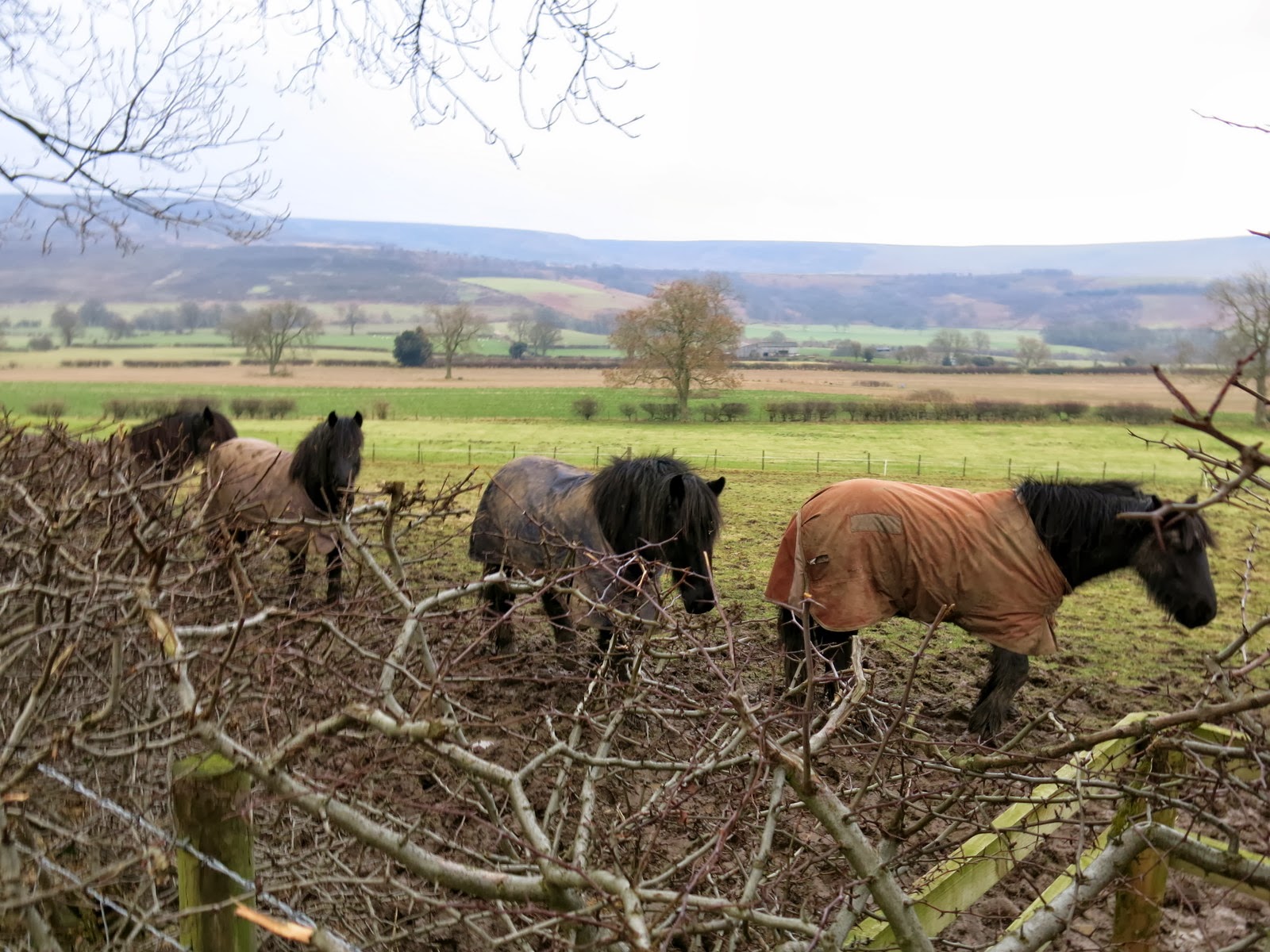Nether and Over Silton to Oakdale Reservoir via Thimbleby Plantation
7 miles Dry, Cold and Grey
We started our walk from the car park at the junction of Hambleton Street and the Hawnby Road, which was already full with cars belonging to a group of beaters who were assembling on the other side of the road, their red flags tucked under their arms. The sound of guns accompanied us throughout the whole walk.
 |
| Today's walk from The Walker's Guide to the Cleveland Hills |
Leaving the car we walked along Hambleton Street, which crosses Thimbleby Moor along the right shoulder of Black Hambleton, and passed through a gate giving access to the conifer plantation. Our path, known as Moor Lane, took us steadily downhill for about 2.5 miles through conifers and with little of interest until we saw the ruins of a lime kiln and later, near Rose Cottage, an ancient drinking trough.
 |
| Passing through Moor Gate, Black Hambleton in the distance |
 |
| Moor Lane |
 |
| Old Lime Kiln |
 |
| Some ponies walk with us hoping for apples | |
|
|
 |
| Rose Cottage |
 |
| Old drinking trough, water still trickling from its spout |
Moor Lane eventually ended at a T junction where we turned right and walked into the pretty village of Nether Silton. We soon spotted the stone monolith which we discussed in an earlier blog post. (See Walk 15th August 2013) We looked at the chapel of All Saints, a medieval church which Tom Scott Burns tells us was rebuilt in 1812 at a cost of £450 raised by subscription and whose alter rails are made from the wood of HMS Dreadnought of Lord Nelson's navy.
 |
| Entering Nether Silton |
 |
| Old Manor Stone monolith |
|
 |
| All Saints at Nether Silton |
Our path left the road opposite the church, as if into a private garden, through a white gate at the side of the old Post Office. There is no way sign on the gate. The path is a pleasant track through several fields but each gate was approached through thick mud because of recent rain. We soon reached the unusual ancient church of St Mary, standing in a secluded field with no approaching paths and whose Jubilee bench made an ideal resting place while we enjoyed our coffee and scones. I have described the church in earlier blogs but this time we were pleased to find an epitaph which TSB refers to and which I photographed.
 |
| 'Hidden' path to Over Silton |
 |
| Field paths to Over Silton |
 |
| St Mary's, Over Silton |
 |
| "All of you who come my grave to see - Prepare yourselves to follow me - Repent in time, no more delay - For youth and Age will soon decay - Life is uncertain, death is sure - Sin is the wound but Christ the cure" | |
|
 |
| Evidence of a picnic at the Jubilee Bench |
Feeling much refreshed we walked across the fields away from the isolated church and towards the village of Over Silton. Here we turned right and walked beyond the houses to a left turn where our path left the road and climbed steeply into Crabtree Bank Plantation. The next 2.5 miles were through conifers, sometimes on wide forestry tracks and sometimes on narrow footpaths but always very muddy and difficult to negotiate. We climbed steeply for the first mile then our path levelled out for a mile before dropping sharply through Big Wood towards Oakdale.
 |
| View from our coffee stop |
 |
| Looking back at isolated St Mary's Church |
 |
| Striding out towards Over Silton |
 |
| Difficult paths all the way through the plantations |
As we walked through the appropriately named Big Wood we saw a couple of strange hides below us; were they for the shooters whose guns had been banging away all through our walk, or birdwatchers? Whoever used them had gone to considerable trouble and expense as they stood at least 30 feet high. Soon we could see down through gaps in the trees to Osmotherley, far below us .
 |
| A Hide? |
 |
| Another hide |
 |
| Climbing through Crabtree Plantation |
 |
| Trying to negotiate a tricky bit |
The descent through the woods to Oakdale Reservoir was very slippery and we hung on to saplings as we slid downwards until we reached a bridge across the stream that runs between the upper and lower reservoirs.
 |
| Looking down from Big Wood towards Osmotherley |
 |
| Clive decides I should get in front of the lens for a change |
 |
| We saw a lot of new signs warning walkers to keep to the right of way |
 |
| Awkward descent towards Oakdale Reservoirs |
 |
| Bridge between reservoirs |
As we approached the upper reservoir we joined the stone path of the Cleveland Way, which would lead us back to where our car was parked. We stopped to admire the old reservoir and a gamekeeper on a quad bike zoomed up followed by several 4 x 4s carrying a shooting party and dogs. The shooting party got out of their vans, all very smartly dressed in tweeds and flat caps with their guns still in leather cases. We quickly left them at the reservoir and started the steep climb back to Hawnby Road and our car. We stopped at the top of the hill to look back at the reservoir just as the first shots were fired.
 |
| Looking back at Big Wood |
 |
| The gamekeeper arrives |
 |
| ... followed by the shooting party |
 |
| Looking back to Upper Reservoir |
|
|
|
|

